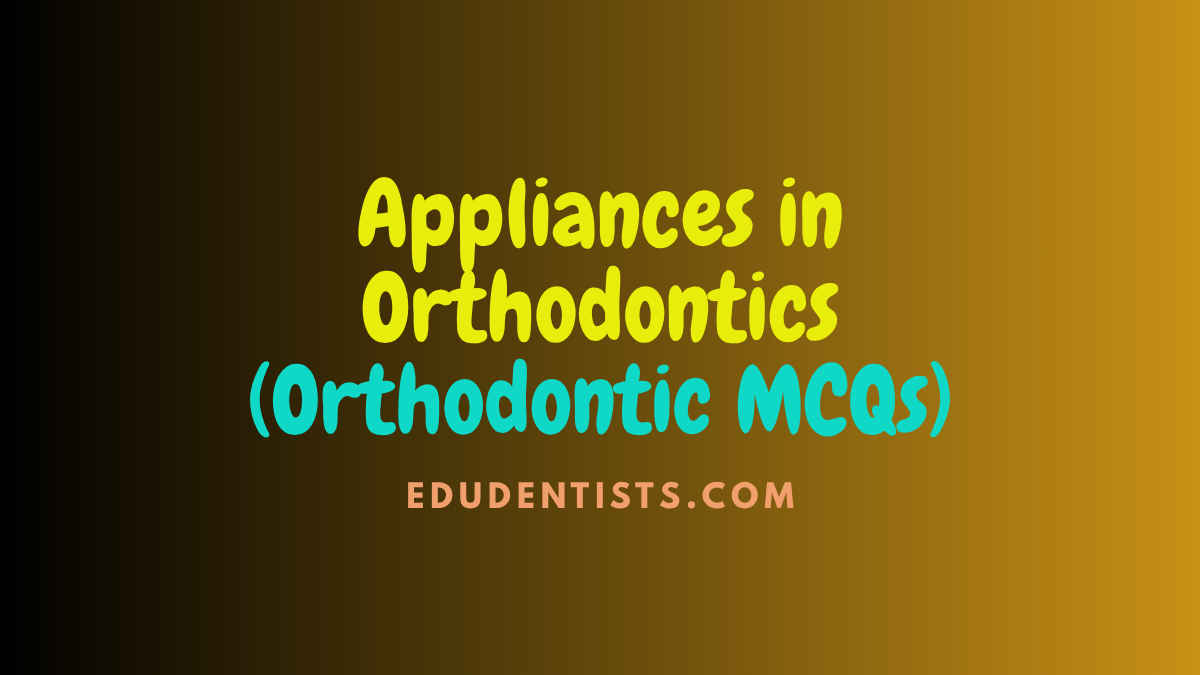
APPLIANCES IN ORTHODONTIC – Ortho MCQs
1. All of the following can be classified as myofunctional appliance except:
A. An anterior bite plane
B. Activator
C. Begg’s appliance
D. Oral screen
2. Oral screens are used for all of the following purposes except:
A. Mouth breathing
B. Tongue thrusting.
C. Lip biting
D. Retraction of upper protruded teeth
3. At which stage is myofunctional appliance given?
A. Primary dentition
B. Mixed dentition
C. Permanent dentition
D. Adulthood
4. Which appliance is not suitable for skeletal C–III malocclusion at the age of 8 years?
A. Frankel III
B. Activator III
C. Chin cap
D. Maxillary splint appliance
5. All of the following appliances were introduced by Edward H Angle except:
A. E-arch appliance
B. Pin and tube appliance
C. Edgewise appliance
D. Straight wire appliance
6. Edge wise appliance are used
A. On incisal edge of anterior teeth
B. With rectangular arch wire
C. With labial arch at incisal and gingival arch of each bracket
D. To obtain edge to edge occlusion
7. Cetlin appliance is used for:
A. Molar distalization
B. Anterior cross bite
C. Posterior cross bite
D. For midline diastema
8. Whip spring is:
A. Fixed
B. Semifixed
C. Removable
D. Functional
9. Example of a fixed functional appliance is:
A. Churro jumper
B. Mandibular anterior reposition appliance (MARA)
C. Sabbagh universal spring (SUS)
D. All of above
10. Orthodontic appliances should not be reactivated more frequently than at:
A. 1 week interval
B. 2 week interval
C. 3 week interval
D. 4 week interval
11. A chin cap should be worn by the patient for at least:
A. 6 hours a day
B. 10 hours a day
C. 14 hours a day
D. 20 hours a day
12. The jasper jumper differs from Herbst appliance in?
A. Effect
B. Rigidity
C. Indications
D. All of the above
13. Functional regulator used in the treatment for correction of open bite is:
A. FR 1c
B. FR 5
C. FR 3
D. FR 4
14. Pterygoid response to activator is seen at:
A. 2–3 weeks
B. 4–6 weeks
C. 6–8 weeks
D. 10–12 weeks
15. Wunderers modification of an Activator is used for correction of which malocclusion?
A. Class 2 div 1
B. Class 3
C. Class 2 div 2
D. Bimaxillary protrusion
16. What type of force is exhibited by a removable functional appliance?
A. Intermittent
B. Interrupted
C. Continuous
D. All of the above
17. Which of the following is an example for Group 1 myofunctional appliance?
A. Activator
B. Bionator
C. Twin block
D. Vestibular screen
18. One of the following is wrong about Herbst appliance?
A. Patience compliance is acceptable
B. It can be worn for 24 hours a day
C. It is fixed
D. Treatment period is long
19. An activator can be used as a passive appliance if:
A. If more than 3 mm of occlusal correction is needed
B. If less than 3 mm of occlusal correction is needed
C. An activator is always active
D. It should not be used for occlusal correction
20. Which one of the following is the flexible fixed functional appliance?
A. Jasper jumper
B. Herbst appliance
C. Twin block
D. Activator
21. Churro jumper was introduced by
A. Castanon R et al.
B. Jaraback
C. John J Stiffler et al.
D. Rickets
22. The term Monoblock was given by:
A. Dr. A Sauver
B. Robin
C. Anderson
D. Rickets
23. Activator is used to correct a retruded mandible by:
A. Inducing growth at symphyseal region
B. Inducing growth at condylar region
C. Selective trimming
D. Mandibular teeth are guided to erupt more in distal direction
24. All of the following are contraindications of an activator except:
A. Adult patient
B. Vertical facial growth pattern
C. Growing patient with class 2 skeletal malocclusion
D. Severe inclination of lower anterior
25. Normal inclination for slopes of twin block appliance is
A. 70 degrees
B. 90 degrees
C. 45 degrees
D. 60 degrees